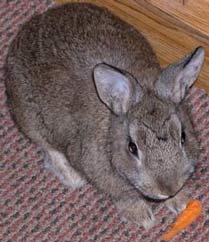AY Honors/Small Mammal Pets/Answer Key
- This article concerns a particular breed of rabbit, the Netherland dwarf. For information on domestic rabbits in general, see Domestic rabbit.
The Netherland dwarf rabbit is a popular breed of domestic rabbit (Oryctolagus cuniculus). Smaller than most rabbit breeds, Netherland dwarf rabbits weigh 1 to 3 lb (0.5 to 1.4 kg) and are usually kept as pets or exhibition animals. They are not typically used as sources of meat or fur because their small size makes them inefficient for these purposes.
Most rabbits sold in pet stores are Netherland dwarfs, Netherland dwarf-derived breeds (often referred to simply as dwarf breeds), or dwarf crosses. Their popularity as pets stems from their babyish appearance and their cage space requirement, which is smaller than that of larger rabbit breeds.
History
The Netherland dwarf was first bred in the Netherlands, as its name implies, in the early 20th century. Medium-sized rabbits of various breeds were bred with wild European rabbits of unusually small size; after several generations the resulting animal was a very small domestic rabbit available in a wide variety of colors and patterns. Netherland dwarfs were first imported into the United Kingdom in the 1950s. In the 1960s and 1970s the United States imported its first Netherland dwarf rabbits.
Early dwarfs, even into the 1970s and 1980s, had fearful and sometimes aggressive temperaments as a result of breeders selecting breeding animals for size, not personality. These rabbits behaved more like wild rabbits than domestic animals and did not make good pets. However, through generations of selective breeding, the modern Netherland dwarf has become a gentle, friendly pet rabbit, though it still retains a more energetic disposition than larger breeds.
Appearance
Purebred Netherland dwarfs come in a wide variety of colors, including Himalayan, Red, Siamese, Chinchilla, Blue, and White-tipped Black. Other colors (called mismarks) exist in non-show-quality Netherland dwarfs and in dwarf mongrel rabbits.
Netherland dwarfs' heads and eyes are disproportionately large with respect to their bodies, and their ears are tiny and carried high on the head. Additionally, their faces are rounded and shortened. These features, a part of the animals' dwarfism, cause them to look infantile even into adulthood.
Dwarf crosses frequently retain some of these characteristics, depending on the breed the dwarf is crossed with. However, crosses rarely look as babyish as the purebred dwarfs and are usually somewhat larger.
Netherland dwarfs as pets
- Main article: Domestic rabbit
Behavior
Netherland dwarf rabbits have the same basic behavioral traits as other domestic rabbits. They can be litter-trained and socialized with dogs and cats.
They tend to have spunkier and more energetic temperaments than larger breeds of rabbit and are rarely content to sit still when outside of the cage. They are curious animals and have a tendancy to nibble on nearby objects and even human beings. However, they are extremely fragile animals and easily stressed, and as such they do not make good pets for young children.
Diet
Like other domestic rabbits, dwarf rabbits consume grasses, grains, and other succulent greens. Their digestive system is somewhat less hardy than their larger cousins, and many leafy vegetables such as lettuce and cabbage can give them health problems. Generally hay and a pelleted feed should make up the largest portion of their diet.
Dwarf breeds
Rabbit breeds derived from breeding larger rabbits with the Netherland dwarf are known as dwarf breeds. Most smaller breeds, like the Mini-Rex, the Jersey Wooly, and the Holland lop, are results of such breedings. Generally dwarf breeds are slightly larger than the typical Netherland dwarf, not growing larger than 4 to 5 lb (1.8 to 2.3 kg). Most have shortened faces compared to larger rabbits, and some even preserve the rounded head, large eyes, or small ears of the Netherland dwarf.
Most dwarf breeds are intended to bring a specialized characteristic, such as a specific fur type, into a smaller rabbit. Mini-Rex were created through the breeding of dwarfs with Rex rabbits, a fur breed with a short, plush coat, and retain both the dwarf's size and the Rex fur. Jersey Woolies are a dwarf version of the Angora rabbit, a wool-producing breed. Lop-eared rabbit breeds, interbred with dwarfs, were used to create Holland lop and Mini-lop rabbits.


